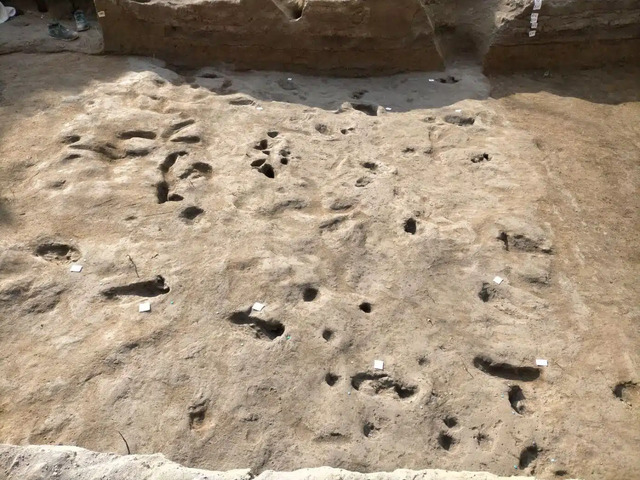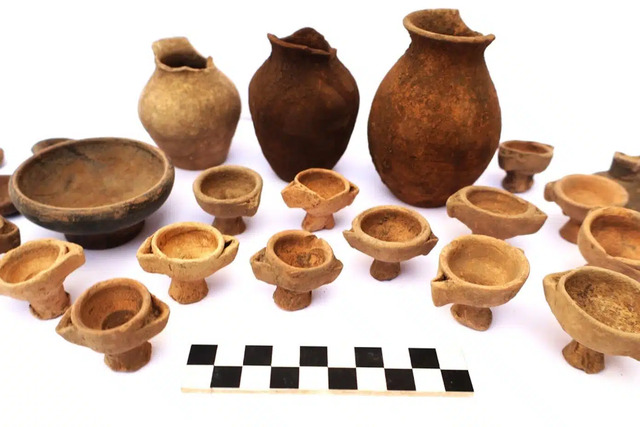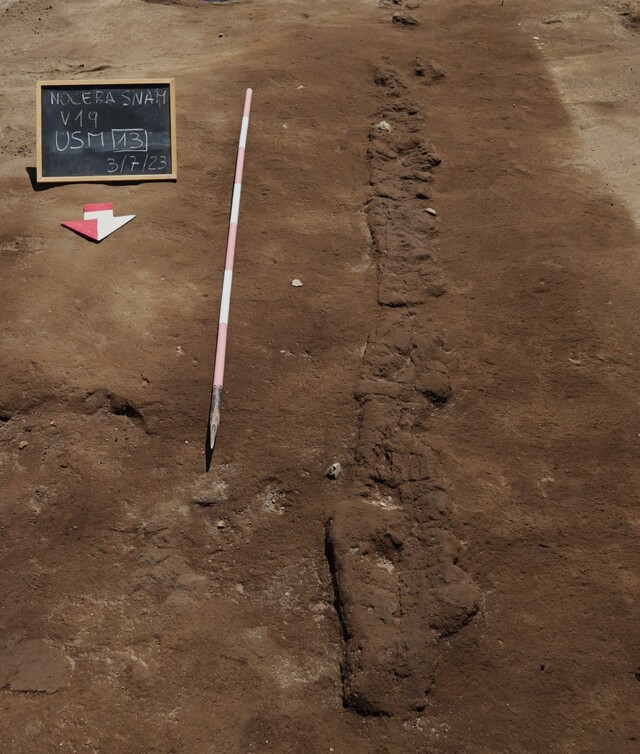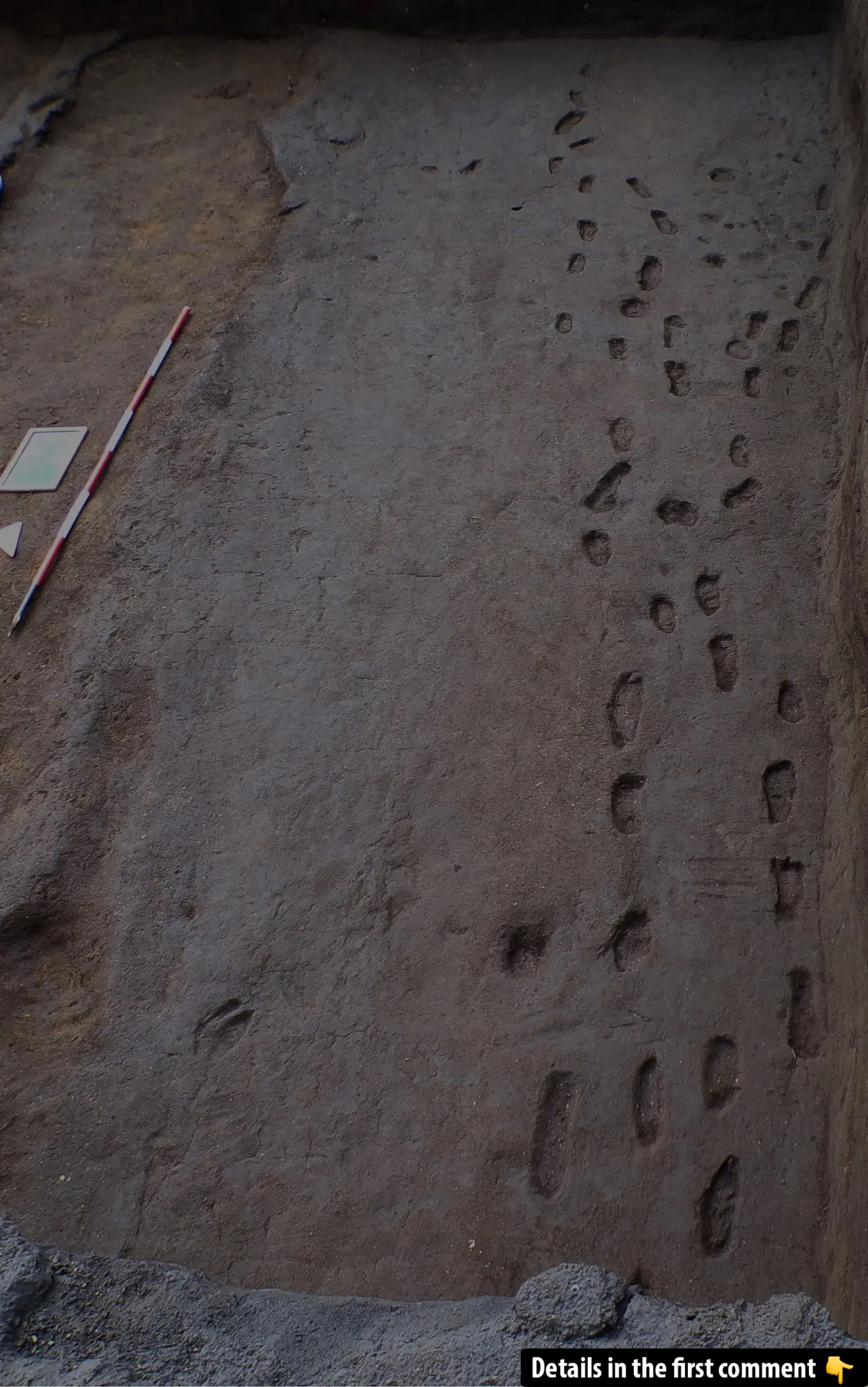In the heart of southern Italy, beneath the shadow of Mount Vesuvius, archaeologists have uncovered a remarkable discovery: ancient footprints left by people and animals fleeing a devastating volcanic eruption. These footprints, dating back over 3,000 years, offer an extraordinary glimpse into life during the early Bronze Age, long before the infamous eruption that destroyed Pompeii. This find not only illuminates a moment of human survival but also reveals the resilience of ancient communities in the face of nature’s fury.
The Avellino Eruption: A Predecessor to the Infamous 79 CE Event
The Avellino eruption, a powerful and violent volcanic event, predates the eruption of Mount Vesuvius in 79 CE by more than a millennium. Archaeologists have long been fascinated by the impact of this eruption, which was far larger in magnitude and affected a much broader region than the eruption that claimed Pompeii. The event that occurred around 2000 BCE left a thick layer of pyroclastic material and ash across the Salerno area, preserving the footprints of people and animals attempting to flee the disaster.

This earlier eruption was part of the same volcanic system that produced the catastrophic eruption in 79 CE, but the scale of destruction was even greater. The region was impacted more extensively, offering a rare insight into the prehistoric society living in its shadow. The discovery of these ancient footprints brings us closer to understanding the impact of volcanic activity on the early Bronze Age communities, shaping our knowledge of the past.
Video
Check out this video to uncover the shocking footprints of Pompeii victims, frozen in time, offering a powerful glimpse into the past.
The Discovery of Footprints and the Escaping Community
The discovery of footprints in the pyroclastic rocks near the Casarzano stream is one of the most compelling aspects of the excavation. These tracks, believed to have been left by men, women, children, and animals, tell a poignant story of people in flight from the eruption. Some of the individuals were barefoot, while others wore basic footwear, further emphasizing the urgency of their escape. The tracks capture the raw human experience in the face of overwhelming natural forces, offering an unparalleled look into the lives of the ancient community.

Archaeologists also uncovered a wealth of pottery, plates, and tools alongside the footprints, revealing important aspects of daily life during this time. These artifacts provide tangible evidence of the society’s routine activities, adding depth to our understanding of how they lived before the eruption disrupted their world. From cooking vessels to tools used for various crafts, the discovery paints a picture of a thriving Bronze Age settlement suddenly and tragically cut short.
Unearthing Bronze Age Artifacts and Pottery
In addition to the footprints, the excavation team uncovered numerous pottery fragments and tools, shedding light on the lives of the people who lived near the foot of the volcano. The presence of these objects in the wake of such a disaster speaks to the ingenuity and resourcefulness of the community. The pottery, in particular, provides insight into the technological advancements and daily practices of these early inhabitants. It is evident that this was a well-established settlement, with its inhabitants engaged in agricultural practices, trade, and perhaps even religious rituals.

Among the most striking discoveries were plates and storage vessels, indicating a complex society that utilized its resources effectively. These ceramics were made from the region’s local clay and were integral to daily life, used for food storage, cooking, and serving. Despite the tragic loss of life caused by the eruption, the material culture that survived offers us a glimpse into the past, a testament to the resilience and creativity of the people who lived in this area.
The Burial Site: Children’s Graves and Ritualistic Slabs
One of the most poignant finds at the site was a burial area containing the remains of children. These graves, covered by slabs of volcanic rock, provided evidence of the community’s burial practices. The graves were carefully arranged, and some of the slabs were intricately carved, indicating a reverence for the deceased and a structured approach to funerary rites.
The presence of child burials is particularly significant, as it highlights the vulnerability of younger members of the community during times of disaster. The graves themselves offer insights into the social structure of the ancient settlement, suggesting that families adhered to ritualistic practices that reflected their beliefs in life after death. The discovery of these graves not only adds depth to the archaeological record but also offers an emotional connection to the people who lived and perished in the wake of the eruption.
The Ancient Village: A Community Before the Catastrophe
Further excavation of the area revealed the remains of an ancient village, complete with hut foundations and fragments of ceramics. This discovery is crucial in understanding the scale and organization of the Bronze Age community that once thrived in the region. The huts, likely made from perishable materials such as wood and mud, were built in a way that suggested a high degree of planning and communal living.

The ceramics found at the site further attest to the presence of a well-populated and structured settlement. These pots and dishes were not only functional but also served as a symbol of cultural identity. The presence of these artifacts suggests that the people of this village engaged in agricultural production, trade, and other forms of craftsmanship, contributing to a robust and thriving society before the eruption upended their lives.
The Sanctuary of Nuceria Alfaterna: A Glimpse of Religious Life
In addition to the footprints and village remains, archaeologists also uncovered an ancient sanctuary near Nuceria Alfaterna, dating to the 3rd or 2nd century BCE. The sanctuary was located along an important communication route, indicating its significance in religious practices and regional trade. Numerous ceramic artifacts were recovered from the site, many of which are believed to have been votive offerings made to deities.
These miniaturized ceramics provide a unique glimpse into the religious practices of the time, highlighting the importance of ritual and spiritual beliefs in the daily lives of the people who lived in the region. The sanctuary’s location and the offerings found within it suggest that the community had access to a broader cultural and religious network, linking them to the wider Mediterranean world.
Roman Villas: Monumental Structures and Agricultural Insights
During the excavation, two monumental Roman villas were uncovered, further enriching the historical narrative of the region. These villas, believed to have been used for agricultural production, played a key role in the local economy. The identification of plow marks at various points on the site indicates that the area was heavily involved in farming, which formed the foundation of the settlement’s economy.
The villas also highlight the importance of the region in the broader Roman world. They were integral parts of a regional trade network, serving as hubs for the distribution of agricultural goods and other commodities. The discovery of these villas not only provides insight into the daily life of the Roman period but also demonstrates the enduring importance of this region for centuries after the eruption.
Video
Watch this video from Lost World of Pompeii to step inside the ancient city that was buried alive, uncovering the secrets of Pompeii’s tragic history.
Conclusion: The Resilience of Ancient Communities
The discovery of footprints, pottery, burial sites, and monumental structures provides a remarkable snapshot of life in ancient Salerno, revealing the resilience of communities in the face of natural disasters. Despite the catastrophic eruption of Mount Somma over 3,000 years ago, the people of this region rebuilt their lives, adapting to the challenges they faced and continuing to thrive long after the disaster.
This find highlights the complexity of ancient societies and their ability to recover from major upheavals. It serves as a reminder of the power of nature and the adaptability of human communities. The excavations in Salerno not only deepen our understanding of ancient volcanic activity but also offer a window into the everyday lives of people who lived in one of the world’s most volatile environments. Through these discoveries, we are reminded that history is not just written in books but preserved in the ground, waiting to be uncovered.



